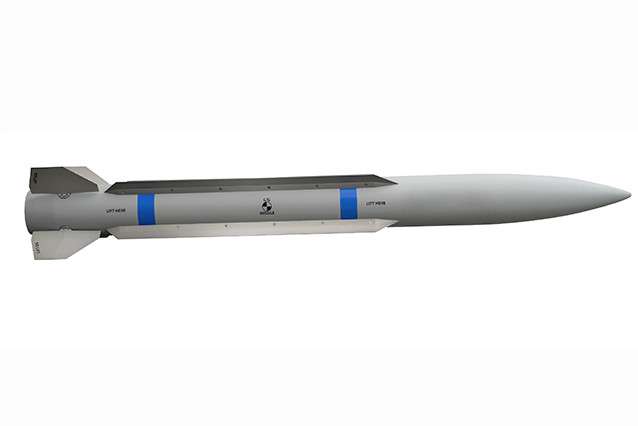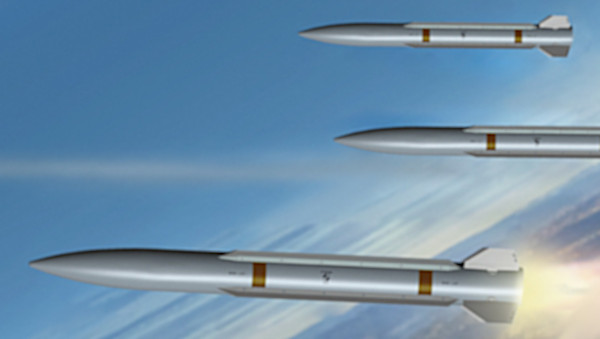Raytheon recently unveiled a new medium-range missile design that is roughly half the size of the company’s existing AIM-120 Advanced Medium-Range Air-to-Air Missile, or AMRAAM, but that it says will have equivalent and in some cases superior performance. The new weapon, called Peregrine, could effectively double the number of missiles that fighter jets such the F-35 Joint Strike Fighter or F-22 Raptor can carry internally, greatly increasing their magazine capacity when they are in their most stealthy configurations.
The Massachusetts headquartered defense contractor revealed Peregrine publicly for the first time at the Air Force Association’s main annual convention outside Washington, D.C., on Sept. 16, 2019. The new missile is presently an internally-funded project and the plan is to offer it as a complement to the AIM-120, as well as the AIM-9X Sidewinder, both of which are Raytheon products, according to Aviation Week.
The company says that Peregrine will have at least as much reach as an AMRAAM and the maneuverability of a Sidewinder, but in a package just six feet long and weighing only 150 pounds. The AIM-120 is around 12 feet in length and tips the scales at around 345 pounds.
“Peregrine will allow U.S. and allied fighter pilots to carry more missiles into battle to maintain air dominance,” Dr. Thomas Bussing, the Vice President of Raytheon Advanced Missile Systems, said in a statement. “With its advanced sensor, guidance and propulsion systems packed into a much smaller airframe, this new weapon represents a significant leap forward in air-to-air missile development.”

Raytheon has otherwise offered limited details so far about its missile’s exact capabilities and features. Mark Noyes, Raytheon Missile Systems Vice President of Business Development and Strategy, told Aviation Week that Peregrine will have a “multi-mode autonomous seeker” and a “new, high-performance propulsion section,” but declined to offers specifics.
The guidance system is tri-mode, according to FlightGlobal, but Raytheon would not say what functionalities it has exactly. A combination of the radar homing capabilities of the AIM-120 with the imaging infrared seeker of the AIM-9X would be the most likely options. This would offer an alternative means of finding the target in the event of electronic warfare jamming during the terminal phase of the missile’s flight. It similarly could rely on the radar seeker if the target’s defensive countermeasures blinded or confused its infrared optics. The third method of operation could be a capability to actively home in on a target’s electromagnetic emissions, such as those from its own radar. A data-link, which it will absolutely have, will only add to the missile’s range and ability to more easily kill targets at closer ranges. You can read all about how a data-link and lock-on-after-launch capability enhances an air-to-air missile’s capabilities dramatically in this previous piece of ours.
Given the very conventional cylindrical shape of the missile’s body as seen so far in Raytheon’s concept art and physical models, the Peregrine uses an advanced rocket motor for propulsion. It’s also unclear what AMRAAM variant Raytheon is comparing Peregrine’s range to, as the capabilities of the later AIM-120C, and especially the AIM-120D, are very different from those of the earlier AIM-120A and B variants. Publicly available estimates put the AIM-120D’s maximum range at between 75 and 100 miles, which is also dependent on a wide variety of factors, including the state of the launch platform, such as its altitude and speed.
“It will be beyond-medium-range. I can’t go into specifics, as you can appreciate,” Raytheon’s Noyes told FlightGlobal. “But it can do everything from short-range to beyond-visual-range to beyond-medium-range.”
A multi-pulse rocket motor using improved, high-grain propellant might be able to provide this kind of range performance in a smaller package. Northrop Grumman uses similar rocket motor technology to give the AGM-88G Advanced Antiradiation Guided Missile-Extended Range (AARGM-ER) significantly greater range over the existing AGM-88E AARGM, but without increasing the weapon’s overall length. Raytheon itself has been investigating a high-grain propellent rocket motor as part of possible updates for the AIM-9X, something The War Zone

Advanced warhead technology, or possibly the elimination of the warhead entirely in favor of a hit-to-kill design that physically slams into its target to destroy it, could allow for more space to go to the propulsion system and its fuel, as well. Peregrine has a blast-fragmentation warhead, according to Aviation Week, but this conflicts with Raytheon’s own concept art, which only shows two brown bands on the body. These denote the presence of low-order explosives and are typically indicators of a missile’s rocket motor. A yellow band, for high explosives, generally shows the location of a warhead.
“It will go supersonic and that’s attributable to that new lightweight airframe and high-performance modular control system,” Raytheon’s Noyes told Aviation Week. “That permits it [to] go and do incredible maneuvers, especially at the endgame where it’s needed most,” he continued, describing the kind of agility that would also be necessary for a hit-to-kill weapon.

Peregrine’s extreme maneuverability is the product of a thrust vectoring system, according to Flight Global. This feature is derived from technology developed for the AIM-9X.
Peregrine doesn’t represent the first time a company has sought to develop a miniaturized beyond-visual-range air-to-air missile. Lockheed Martin touted a very similar weapon, called Cuda, in the early 2010s, though it has largely disappeared from the company’s marketing in recent years. The Air Force has also been exploring this category of missiles in recent years through programs such as the Small Advanced Capability Missile (SACM) and Miniature Self-Defense Munition (MSDM).
From what we know of Cuda, this weapon was to offer a shorter range than the AIM-120 and was also expected to be hit-to-kill. Curiously, all of the concept art and models for this missile, however, showed a yellow band indicating a warhead in the forward body and what looked to be a pre-fragmented “sleeve” that would turn into a hail of shrapnel after the detonation.

It’s also worth noting that Raytheon lost the AIM-260 Joint Air Tactical Missile (JATM) competition to Lockheed Martin, but the company is still reportedly developing the Long Range Engagement Weapon (LREW). Peregrine may leverage design features from the company’s JATM proposal or its work on LREW.
Whatever the case, any half-size medium-range air-to-air missile could offer significant benefits to a modern combat jet, especially stealthy designs that have to carry their weapons internally to maximize their radar-evading capabilities. At present, the F-35, for example, can only carry four AIM-120s internally, while the F-22 can carry six in its main weapon bay. Peregrine offers the potential for those aircraft to double their magazine capacity without any major modifications. Lockheed Martin is also working on an upgrade for the Joint Strike Fighters, called Sidekick, that would allow them to carry three AMRAAMs in each of their bays. These aircraft could then be able to carry a dozen of Raytheon’s new missile. It would also solve the F-35’s problem of not having an American dogfight missile available for internal carriage.
Even if Peregrine’s range turns out to be significantly less than the AIM-120D, the ability for stealthy aircraft to carry relatively large numbers of them in combination with full-size AMRAAMs, or future missiles, such as the AIM-260, could be extremely beneficial. The AIM-260, which you read about more in this past War Zone story, aims to be an AMRAAM-sized weapon with considerably greater range and other improvements.

A mixture of Peregrines and other weapons, including the AIM-260 and future subvariants of the AIM-9X, could offer pilots additional options for engaging targets and defending themselves. With its multi-mode guidance system, Raytheon’s new missile may have nascent air-to-surface capabilities that could also make it a useful tool for engaging other target sets, including pop-up air defense threats. Regardless, it will be extremely hard to jam, deceive, or outmaneuver.
The value of Peregrine’s compact size isn’t limited to stealth fighter jets, either. Advanced fourth-generation fighter jets could massively increase their magazine depth, as well.
It could be a useful addition to larger aircraft, even stealth bombers, such as the future B-21, as an option for emergency self-defense against incoming missiles and other threats. It would also be an ideal armament option for smaller unmanned combat air vehicles (UCAV), which look increasingly set to become an important component of the aerial combat ecosystem in the future.
Still, there are additional questions. If it has the same maneuverability as an AIM-9X, but the range of an AMRAAM, and a tri-mode seeker, would there still be a high-demand for AIM-9X outside of the demand to equip aircraft with wingtip rails? Likewise, where does the AIM-120 fit in? If this has the range of an AIM-120D, then that missile would only seem to offer more utility for taking down larger targets at the loss of major magazine capacity.
If Peregrine has a similar range to the AIM-120C, but not the AIM-120D, it will be interesting to see if it cannibalizes some of that market share. Also, how much will it have to compete with USAF-funded missile programs that are ongoing, the details of which remain tightly guarded? Does Raytheon see this as a middle-end capability that will exist between the AIM-260 and AIM-9X once that new AIM-260 is in service? That would help offset some of the losses the company will experience from being knocked off its throne as America’s primary medium/long-range air-to-air missile supplier.
But above all else, this could satisfy one of the F-22 Raptor pilot community’s biggest wishes—having more missiles to play with. The F-35 as well, but to a lesser degree at this time. Stealth fighters like the Raptor don’t require the long-range capability that the AIM-120D provides as they can get closer to their aerial opponents while remaining undetected under many circumstances. So, exchanging missile range for greater magazine depth is a very logical tradeoff for 5th generation fighter crews. 4th generation fighters, on the other hand, would put a higher premium on missile range to better offset their survivability deficiencies.
Raytheon has not yet offered any details about a potential schedule for developing and testing Peregrine before formally bringing it to market. Aviation Week noted that the company had trademarked the name in August 2018, though it is still unclear how far along the project is already.
The War Zone will certainly be keeping a close eye on this project, which could be an extremely important addition to the U.S. military’s aerial arsenal, as well as those of foreign customers, especially those also flying stealthy jets, such as the F-35, in the future.
Contact the author: Tyler@thedrive.com
